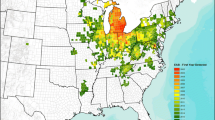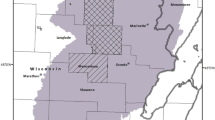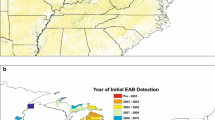Abstract
Emerald ash borer (EAB; Agrilus planipennis, Coleoptera: Buprestidae) causes large economic costs by killing ash trees (Fraxinus spp.): a process that takes several years of infestation. We suggest that the most important prediction regarding this species is not whether EAB can persist indefinitely in a new region, but whether it can persist long enough to kill trees. We use a mechanistic model of overwintering mortality of EAB prepupae to identify Canadian cities and more generally, those areas of North America at risk of impact. Although we have previously used a Newtonian cooling model to predict underbark temperatures of ash from meteorological data, we show that a linear regression model has smaller errors for the low winter temperatures relevant to EAB mortality. Using this regression model we generate distributions of predicted underbark temperatures which we then use to predict the return time of weather events cold enough to cause either complete (99%) or partial (75%) mortality of overwintering EAB prepupae. We find that most of North America does not experience extreme cold events frequently enough to prevent ash mortality from EAB (i.e., more frequently than every 6 years), and therefore conclude that large economic impacts are likely throughout the continent. However, if relatively frequent partial mortality events are sufficient to reduce ash mortality, there is a possibility of northern refugia for ash species, and some northern Canadian sites may escape the costs of this non-native pest.







Similar content being viewed by others
References
Bartos D, Amman G (1989) Microclimate: an alternative to tree vigor as a basis for mountain pine-beetle infestations. USDA Forest Service Intermountain Research Station research paper, pp 1–10
Bates D, Maechler M, Bolker B, Walker S (2015) Fitting linear mixed-effects models using lme4. J Stat Softw 67:1–48. https://doi.org/10.18637/jss.v067.i01
Bolstad P, Bentz B, Logan J (1997) Modelling micro-habitat temperature for Dendroctonus ponderosae (Coleoptera: Scolytidae). Ecol Model 94:287–297
Buckley LB, Urban MC, Angilletta MJ, Crozier LG, Rissler LJ, Sears MW (2010) Can mechanism inform species’ distribution models? Ecol Letts 13: 1041–1054
Cappaert D, McCullough DG, Poland TM, Siegert NW (2005) Emerald ash borer in North America: a research and regulatory challenge. Am Entomol 51:152–165
CFIA (2017) Areas Regulated for the Emerald Ash Borer. http://www.inspection.gc.ca/plants/plant-pests-invasive-species/insects/emerald-ash-borer/areas-regulated/eng/1347625322705/1367860339942. Accessed 23 June 2017
Chen Y, Ciaramitaro T, Poland TM (2011) Moisture content and nutrition as selection forces for emerald ash borer larval feeding behaviour. Ecol Entomol 36:344–354
Cipollini D, Wang Q, Whitehill JGA, Powell JR, Bonello P, Herms DA (2011) Distinguishing defensive characteristics in the phloem of ash species resistant and susceptible to emerald ash borer. J Chem Ecol 37:450–459
City of Toronto (2011) City of Toronto holding information sessions on Emerald Ash Borer infestation. Accessed 20 Nov 2013
Coles S (2001) An introduction to statistical modeling of extreme values. Springer, London
Crosthwaite JC, Sobek S, Lyons DB, Bernards MA, Sinclair BJ (2011) The overwintering physiology of the emerald ash borer, Agrilus planipennis Fairmaire (Coleoptera: Buprestidae). J Insect Physiol 57:166–173
Cuddington K, Hastings A (2016) Autocorrelated environmental variation and the establishment of invasive species. Oikos 125:1027–1034
DeSantis RD, Moser WK, Gormanson DD, Bartlett MG, Vermunt B (2013) Effects of climate on emerald ash borer mortality and the potential for ash survival in North America. Agric For Meteorol 178:120–128
DiMeglio AS, Wallingford AK, Weber DC, Kuhar TP, Mullins D (2016) Supercooling points of Murgantia histrionica (Hemiptera: Pentatomidae) and field mortality in the mid-Atlantic United States following lethal low temperatures. Enviro Entomol 45:1294–1299
Environment Canada (2012) http://climate.weather.gc.ca/climate_normals/. Accessed 20 Nov 2013
ESRI (2013) ArcGIS Desktop: Release 10.2. Environmental Systems Research Institute, Redlands
Eyles A, Jones W, Riedl K, Cipollini D, Schwartz S, Chan K, Herms DA, Bonello P (2007) Comparative phloem chemistry of manchurian (Fraxinus mandshurica) and two north american ash species (Fraxinus americana and Fraxinus pennsylvanica). J Chem Ecol 33:1430–1448
Fierke MK, Whitmore MC, Foelker C, Vandenberg JD, Carlson J (2013) Delimitation and management of emerald ash borer (Coleoptera: Buprestidae): case study at an outlier infestation in southwestern New York State, United States of America. Can Entomol 145:577–587
Gandhi KJK, Herms DA (2010) North American arthropods at risk due to widespread Fraxinus mortality caused by the Alien Emerald ash borer. Biol Invasions 12:1839–1846
Gilleland E, Katz RW (2016) extRemes 2.0: an extreme value analysis package in R. J Stat Softw 72:1–39. https://doi.org/10.18637/jss.v072.i08
Herms DA, McCullough DG (2014) Emerald ash borer invasion of North America: history, biology, ecology, impacts, and management. Ann Rev Entomol 59:13–30
Hijmans RJ (2015) raster: geographic data analysis and modeling. R package version 2.3-40. http://CRAN.R-project.org/package=raster
Hudgins EJ, Liebhold AM, Leung B (2017) Predicting the spread of all invasive forest pests in the United States. Ecol Lett 20:426–435
Kearney M, Porter W (2009) Mechanistic niche modelling: combining physiological and spatial data to predict species’ ranges. Ecol Lett 12:334–350
Knight KS, Brown JP, Long RP (2013) Factors affecting the survival of ash (Fraxinus spp.) trees infested by emerald ash borer (Agrilus planipennis). Biol Invasions 15:371–383
Liang L, Fei S (2014) Divergence of the potential invasion range of emerald ash borer and its host distribution in North America under climate change. Clim Change 122:735–746
Little EL (1971) Atlas of United States trees volume 1 conifers and important hardwoods. Miscellaneous publication 1146. U.S. Department of Agriculture, Forest Service, Washington, DC
McCullough DG, Mercader RJ (2012) Evaluation of potential strategies to SLow Ash Mortality (SLAM) caused by emerald ash borer (Agrilus planipennis): SLAM in an urban forest. Int J Pest Manag 58:9–23
McKenney DW, Hutchinson MF, Papadopol P, Lawrence K, Pedlar J, Campbell K, Milewska E, Hopkinson RF, Price D, Owen T (2011) Customized spatial climate models for North America. Bull Am Meteorol Soc 92:1611–1622
McKenney DW, Pedlar J, Yemshanov D, Lyons B, Campbell K, Lawrence K (2012) Estimates of the potential cost of Emerald Ash Borer (Agrilus planipennis Fairmaire) in Canadian municipalities. Arbor Urban For 38:81–91
Mercader RJ, Siegert NW, Liebhold AM, McCullough DG (2011) Simulating the effectiveness of three potential management options to slow the spread of emerald ash borer (Agrilus planipennis) populations in localized outlier sites. Can J For Res 41:254–264
Mohsin T, Gough W (2010) Trend analysis of long-term temperature time series in the Greater Toronto Area (GTA). Theor Appl Climatol 101:311–327
Nkemdirim LC, Truch P (1978) Variability of temperature fields in Calgary, Alberta. Atmos Environ 12:809–822
Oke TR, Maxwell GB (1975) Urban heat island dynamics in Montreal and Vancouver. Atmos Environ 9:191–200
Orlova-Bienkowskaja MJ (2014) Ashes in Europe are in danger: the invasive range of Agrilus planipennis in European Russia is expanding. Biol Invasions 16:1345–1349
Pinheiro J, Bates D, DebRoy S, Sarkar D, R Core Team (2017) nlme: linear and nonlinear mixed effects models. R package version 3.1-131. https://CRAN.R-project.org/package=nlme
R Core Team (2013) R: A language and environment for statistical computing. R Foundation for Statistical Computing, Vienna, Austria. http://www.R-project.org/
Sobek-Swant S, Crosthwaite JC, Lyons DB, Sinclair BJ (2012a) Could phenotypic plasticity limit an invasive species? Incomplete reversibility of mid-winter deacclimation in emerald ash borer. Biol Invasions 14:166–173
Sobek-Swant S, Kluza DA, Cuddington K, Lyons DB (2012b) Potential distribution of emerald ash borer: What can we learn from ecological niche models using Maxent and GARP? For Ecol Manag 281:23–31
Strasser CA, Lewis MA, DiBacco C (2011) A mechanistic model for understanding invasions: using the environment as a predictor of population success. Divers Distrib 17:1210–1224
Taylor RAJ, Bauer LS, Poland TM, Windell KN (2010) Flight Performance of Agrilus planipennis (Coleoptera: Buprestidae) on a flight mill and in free flight. J Insect Behav 23:128–148
Tran JK, Ylioja T, Billings RF, Regniere J, Ayres MP (2007) Impact of minimum winter temperatures on the population dynamics of Dendroctonus frontalis. Ecol Appl 17:882–899
Ungerer MJ, Ayres MP, Lombardero MJ (1999) Climate and the northern distribution limits of Dendroctonus frontalis Zimmermann (Coleoptera: Scolytidae). J Biogeogr 26:1133–1145
USGS United States Geological Survey (1999) Digital representation of atlas of United States trees. In: Little Jr, Elbert L (eds). http://esp.cr.usgs.gov/data/atlas/little/
USDA Cooperative Emerald Ash Borer Project (2017) New county detection map. https://www.aphis.usda.gov/plant_health/plant_pest_info/emerald_ash_b/downloads/NewCountyDetectionMap2017.pdf. Accessed 23 June 2017
Valenta V, Moser D, Kuttner M, Peterseil J, Essl F (2015) A high-resolution map of emerald ash borer invasion risk for Southern Central Europe. Forests 6:3075–3086
Vermunt B, Cuddington K, Sobek-Swant S, Crosthwaite J (2012) Cold temperature and emerald ash borer: modelling the minimum under-bark temperature of ash trees in Canada. Ecol Model 235:19–25
Wang X, Feng Y, Vincent L (2014) Observed changes in one-in-20 year extremes of Canadian surface air temperatures. Atmos Ocean 52:222–231
Wei X, Reardon D, Wu Y, Sun JH (2004) Emerald ash borer, Agrilus planipennis Fairmaire (Coleoptera: Buprestidae), in China: a review and distribution survey. Acta Entomol Sin 47: 679–685
Wei X, Wu Y, Reardon R, Sun T, Lu M, Sun J (2007) Biology and damage traits of emerald ash borer (Agrilus planipennis Fairmaire) in China. Insect Sci 14:367–373
Whitehill JGA, Opiyo SO, Koch JL, Herms DA, Cipollini DF, Bonello P (2012) Interspecific comparison of constitutive ash phloem phenolic chemistry reveals compounds unique to Manchurian ash, a species resistant to emerald ash borer. J Chem Ecol 38:499–511
Zuur AF, Ieno E, Walker NJ, Saveliev A, Smith GM (2009) Mixed effects modelling for nested data. Mixed effects models and extensions in ecology with R. Springer, New York, pp 101–142
Acknowledgements
Funding for this study was obtained through an NSERC (Natural Sciences and Engineering Research Council of Canada) Strategic Grant to Kim Cuddington and Brent Sinclair. Our thanks go to the Canadian Food Inspection Agency, the Canadian Forest Service, the London Psychiatric Hospital and the Sarnia Golf and Curling Club for access to field sites for sampling EAB and helpful advice. Experimental work was conducted in the Biotron Centre for Experimental Climate Change Research at the University of Western Ontario using CFI (Canadian Foundation for Innovation) funded equipment. We also acknowledge David (Xinyang) Bing, Joshua Farhi and Greg Watkinson for their assistance with EAB sampling and lab work. We are further grateful to Joan Costello, Lori Costello, Diane Tregunna and the North Bay Jail, Josef Ric, Alex Bykov and the City of Toronto foresters, Rick Knapton and the Cataraqui Region Conservation Authority, Eugene Conners and the City of Kingston, Jason Pollard and the City of Ottawa, as well as Chris Saunders, Mark Wartenbe, Mike Jenkins and the City of Edmonton for granting access to field sites and ongoing support, provision of time, manpower and equipment for installing and maintaining data loggers in ash trees. Air temperature maps of North America were obtained from Dan McKenney at Natural Resources Canada. The support of Dan and his staff was invaluable in completing this work.
Author information
Authors and Affiliations
Corresponding author
Appendix
Appendix
We used gridded daily extreme winter minimum data for Canada as the input to the best fit Newtonian cooling model (daily data from this source was not available for all of North America) to predict the probability of EAB mortality events. The Newtonian cooling model based on daily minimum temperatures predicted more frequent complete mortality events (99% mortality) in Canada than the linear regression model, and consequently a smaller area of economic risk. The Newtonian model predicted some small areas inside the native range of ash in Canada that would experience complete mortality every 1–3 years (Fig. 8). However, the area predicted for frequent complete mortality events excluded most Canadian urban centers. Therefore we interpret this model as predicting the potential for a small northern refuge for ash, but large economic impact for many Canadian cities. Of course, for 75% mortality events, a Newtonian cooling model predicts a much larger potential refuge for ash. This prediction suggests that that northern cities such as Edmonton and Saskatoon might escape significant economic impact of this invasive pest.
Return time for a 99% EAB prepupae mortality event as predicted by the probability of − 35.4 °C underbark temperatures given by a Newtonian cooling model relating daily air temperature minimum to underbark temperature for annual winter minimum temperatures from 1993–2013. In addition to return times, areas where air temperatures cold enough to cause underbark temperatures colder than − 35.4 °C have been observed at least once between 1993 and 2013 (light blue). Circles indicate major urban centers in Canada considered (see Table 1). Purple line gives range of four major Fraxinus species in North America as indicated by Little (1971)
Rights and permissions
About this article
Cite this article
Cuddington, K., Sobek-Swant, S., Crosthwaite, J.C. et al. Probability of emerald ash borer impact for Canadian cities and North America: a mechanistic model. Biol Invasions 20, 2661–2677 (2018). https://doi.org/10.1007/s10530-018-1725-0
Received:
Accepted:
Published:
Issue Date:
DOI: https://doi.org/10.1007/s10530-018-1725-0





